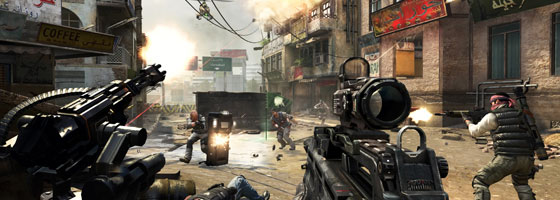By the time you read this, the craziness of the Black Friday/Cyber Monday sales will be over for the Game Industry. The sales this year were certainly a surprising bunch; especially for the AAA market. And while it was great from a consumer standpoint, I had a moment of abject terror thinking about what it means for getting into the game industry.
Price Wars:
This year, the line between AAA and indie game value blurred even more for the holiday season. Recent games like Shadow of War and Wolfenstein were discounted to $25 in some areas. Horizon Zero Dawn, one of the most highly celebrated games of the first half of 2017 was dropped down to $20.
As a point of comparison, I bought the Grim Dawn expansion for $15 during the Steam sale. Now I know that some of you reading this are saying to yourselves, “Wow, those are some great sales for the industry,” but that’s not the case.
The devaluation of the game industry is a serious issue, and this year’s sales are very much proof of that.
Dollars to Donuts:
In a post I wrote awhile ago, I talked about how pricing a video game is a difficult task and that it’s no longer a qualifier for value. From free to $60, there is a very wide spectrum in terms of game pricing.
While we could argue that the higher price is meant for games that cost more to make, that doesn’t necessarily mean they’re worth it. I have bought $30 and up games that I’ve gotten less time in compared to $10 and under.
Going back to the last section, there is a very big problem when one of the highest rated games of 2017 is priced $5 more than an expansion to an indie game.
For a long time, we have seen that quality no longer is a measurement for price. When AAA and indie games are both priced around the same, this creates an issue on both sides. For AAA games, if people are only expecting to pay $25 or less for your big budget title, how are you supposed to turn a profit when you were originally priced at $60?
In the indie space, why should someone try out your game when they can spend a few dollars more and get a AAA experience with all the trimmings?
Oasis of Success:
There’s no denying that the Game Industry as a whole pulls in a lot of money. According to the ESA, the Game Industry generated 30.4 billion dollars in revenue last year, and that’s up from 23.5 billion in 2015.
When you hear numbers like that, it’s easy to assume that everyone is enjoying the success. However, just like in the mobile space, this presents a hidden problem.
The game industry is a boom or bust market. For a lot of studios, they are just one failed game away from being closed. The games that do succeed can create franchises that will keep bringing in money with each iteration. No one is going to say that Call of Duty, Battlefield, or Uncharted weren’t successful, but what about everyone else?
Consumers are certainly spending more money on games with each year, but how much of that is reaching everyone? As we saw last decade with the MMO crash, once something becomes successful, it then becomes almost impossible to unseat it.
Just because Call of Duty is a profitable game, doesn’t mean that your military FPS is going to come anywhere near it. People are going to flock to the games that are the most recognized and at the best price; making it harder for someone else to turn a profit.
The Risky Nature of Games:
Game devaluation is a serious problem, and one that is making it very risky to enter the game industry. Here’s the point that I feel people are missing: The games that were going to sell well will continue to do so regardless of the market.
It doesn’t matter if Blizzard sells Overwatch for $50 or $20, it’s going to turn a profit. EA, Activision, Nintendo, and Blizzard can never complain about their games not making enough money at this point. The market for their games is so entrenched, that they rarely have to discount their games.
For everybody else however, that’s a different story. This is why analysts and members of the industry say that social media and PR work are so important to succeeding today. The chance of a game coming out of the ether and being successful is very low. You’re either going to be a massive hit with YouTubers and streamers shouting your game’s praises to the winds, or you won’t make a dent at all.
And having your game be a minor success just doesn’t happen all that often today. Not when you have AAA games sitting right next to an indie game on the digital store shelf. The question now turns to what can be done, and there’s an interesting idea floating around for just that.
Games as a Service:
The term “Games as a Service,” has been perverted as of late thanks to loot boxes and microtransactions on top of a $60 purchase. The original idea does have merit as a possible alternative to yearly iterations.
Instead of creating an annual franchise that requires development on new iterations, focus on one game that becomes the foundation and keep supporting it with new content. The original plan for Destiny was to create a game compelling and content-rich enough to keep people coming back, and while it didn’t work out, the concept could work.
Titles like Payday 2, Team Fortress 2, and League of Legends to name a few have shown just how effective this can be in terms of building and maintaining a community. This console cycle is the first one to feature upgrades from Sony and Microsoft as opposed to brand new systems to support; allowing the respective games to still remain current. In terms of graphical power and fidelity, eventually we’ll reach a point where the massive jumps aren’t happening anymore (some could argue that we’re there now.)
As I mentioned in the vlog linked above, the idea of a free to play AAA game built on a games as a service model isn’t outside the realm of possibility.
Risky Business:
The Game Industry despite what it seems can be a very risky business to enter. This is currently an industry where there is no defined concept of value and pricing, and games with millions of dollars of development and marketing are being priced next to those that spent a fraction of that.
In an industry of boom and bust, you never know what game will become the next Minecraft or Undertale, and the ones that just fade into obscurity.




